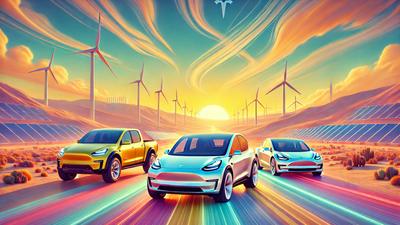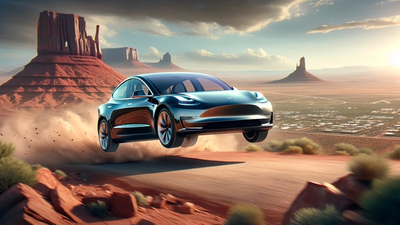See which EVs are joining Tesla’s charging network and adopting the NACS plug.
Driving an electric vehicle is getting a whole lot easier. Tesla’s North American Charging Standard (NACS) charging network, considered to be the best charging infrastructure in the world, is joining forces with other major automakers, allowing them to adopt this revolutionary technology and make it available to their customers.
A wide variety of automakers have partnered with Tesla to provide NACS charge ports on their vehicles, giving drivers the ability to access and use the vast network of chargers and Tesla Superchargers to power their electric cars and trucks.
For many drivers, one of the biggest factors preventing them from making the move to electric is the fear that they’ll be unable to find sufficient charging stations to power their EV, leaving them frantically searching for chargers on road trips or driving well out of their way to find a place to recharge their batteries.
This fear, commonly known as “range anxiety,” has kept some drivers from embracing the future of electric mobility. Not anymore. With a vast worldwide network of charging stations and Tesla Superchargers now available to nearly every electric vehicle automaker, EV drivers can rest assured that finding quick and available power when needed will not be an issue.
What Makes the NACS So Great?
Back in 2012, Tesla introduced a proprietary charging connector for its Model S, which it later expanded to subsequent EV models, such as the Model X, Model 3, Model Y, and Cybertruck. At the same time, Tesla began establishing its Supercharger network around the world as part of the company’s effort to solidify its position in the EV market.
Fast forward ten years, and Tesla chargers, now known as the North American Charging Standard (NACS), have become the gold standard for EV charging. The connector's compact design, along with the extensive coverage of Tesla's Supercharger network, which boasts 60% more NACS posts than all other networks combined, made it an easy choice for standardization.
In June of 2023, SAE International announced the standardization of the Tesla charger as SAE J3400. This officially created a unified standard in the industry and opened up the possibility for other automakers to adopt the system and provide greater compatibility and convenience for other electric vehicle drivers. Originally only available to Tesla owners, the NACS is now on the open market.
Automakers Rush to Embrace NACS Technology
In June of 2023, Ford was the first domino to fall, becoming the first major automaker to collaborate with Tesla and announce its adoption of the NACS plug. Since then, a wave of agreements has followed, with many prominent automakers signing on to integrate the NACS charge port into their EV models in the coming years.
Now, the list of automakers embracing Tesla's NACS charge port includes industry giants such as BMW, General Motors, Honda, Hyundai, Jaguar, Kia, Lexus, Mercedes-Benz, Mini, Nissan, Volvo, Rivian, Rolls-Royce, Subaru, Toyota, and more. Some automakers will even offer in-car apps to pay for charging and pre-programmed navigational features that will direct drivers to the nearest charging ports.
These partnerships are not only a testament to the universality and quality of the Tesla charging technology but also show the electric vehicle industry’s collective commitment to improving the EV ecosystem for drivers.
Of course, not everyone is on board. Notable holdouts include auto giants Volkswagen and Stellantis. However, more and more brands are joining Tesla’s NACS network, and as Supercharger stations continue to expand well beyond third-party prevalence, it’s hard to see this resistance to standardization lasting very long. In fact, EV Station has even created a handy Tesla NACS Adoption Tracker, so you can keep up on which automakers are joining the network and when.
At a Glance: Who is Joining the NACS Network and When?
Automaker | Date | Details |
|---|
BMW | Early 2025 | NACS plug will come standard on 2025 models; existing EVs with CCS ports will connect through an adapter. |
Fisker | 2025 | NACS plug will come standard on 2025 models; existing EVs with CCS ports will connect through an adapter. |
Ford | Spring 2024 | NACS plug will come standard on new models; existing EVs with CCS ports will connect through an adapter. |
Genesis | Late 2024 | NACS plug will come standard on new models; existing EVs with CCS ports will connect through an adapter. |
General Motors | 2024 | NACS plug will come standard new models; existing EVs with CCS ports will connect through an adapter. |
Honda | 2025 | NACS plug will come standard on 2025 models; existing EVs with CCS ports will connect through an adapter. |
Hyundai | Late 2024 | NACS plug will come standard on new models; existing EVs with CCS ports will connect through an adapter. |
Jaguar | 2025 | NACS plug will come standard on 2025 models; adapters will be provided for existing I-Pace owners. |
Kia | Late 2024 | NACS plug will come standard on new models; existing EVs with CCS ports will connect through an adapter. |
Lexus | 2025 | NACS plug will come standard on 2025 models; existing EVs with CCS ports will connect through an adapter. |
Lucid | 2025 | NACS plug will come standard on 2025 models; existing EVs with CCS ports will connect through an adapter. |
Mercedes-Benz | 2025 | NACS plug will come standard on 2025 models; existing EVs with CCS ports will connect through an adapter. |
Mini | Early 2025 | NACS plug will come standard on 2025 models; existing EVs with CCS ports will connect through an adapter. |
Nissan | 2025 | NACS plug will come standard on 2025 models; existing EVs with CCS ports will connect through an adapter. |
Polestar/Volvo | 2025 | NACS plug will come standard on 2025 models; existing EVs with CCS ports will connect through an adapter. |
Rivian | 2025 | NACS plug will come standard on 2025 models; existing EVs with CCS ports will connect through an adapter. |
Rolls-Royce | Early 2025 | NACS plug will come standard on 2025 models; existing EVs with CCS ports will connect through an adapter. |
Subaru | 2025 | NACS plug will come standard on some 2025 models; existing EVs with CCS ports will connect through an adapter. |
Toyota | 2025 | NACS plug will come standard on 2025 models; existing EVs with CCS ports will connect through an adapter. |
The Impact of the NACS on EV Adoption
With the recent resolution of labor disputes at Ford, GM, and Stellantis, the industry seems to be placing a new focus on addressing the broader challenges facing the EV market.
The widespread adoption of Tesla's NACS charging technology is a promising move for the future of EVs. Having a standardized and vast network of EV charging stations solves a variety of issues and paves the way for a smoother transition between ICE engines and the electric future.
Let's explore a few of the major benefits of NACS adoption.
Alleviating Range Anxiety
The fear of running out of battery power, often referred to as "range anxiety," has been a significant barrier to EV adoption. The standardization of Tesla's NACS charge port creates a widely accessible EV charging infrastructure of superior chargers, which will allow drivers to feel comfortable that they will be able to find a charging station when they need one, no matter where they are.
Improving EV Performance
The NACS charge port is known for its high charging speeds compared to CCS chargers, enabling faster and more efficient EV charging. As more automakers embrace this technology, EVs will be able to deliver enhanced performance, making electric vehicles an even more attractive option for drivers who value speed and efficiency.
Taking EVs to the Mainstream
With a unified EV charging standard, drivers can feel a lot more comfortable making the switch to electric vehicles. The collaborative effort among major automakers shows that if the industry works together to improve technology and infrastructure, the vast benefits of EVs, both to drivers and the planet, will be more easily accessible.
The move toward a standardized charging system is good for automakers and individuals alike. A shared infrastructure encourages collaboration, innovation, and the growth of a sustainable electric ecosystem.
Other Charging Networks Getting on Board
Tesla’s Supercharger network is widely regarded as the superior option to many third-party EV charging stations. Third-party networks, such as ChargePoint and Electrify America, often feature CCS plugs and the less utilized CHAdeMO charging standard and are not as prevalent as the Tesla network. Tesla claims to have over 45,000 Superchargers worldwide, 12,000 of which are located in the United States.
The good news? Not only are automakers recognizing the superiority of Tesla's NACS connector, but charging networks are too. Both ChargePoint and Electrify America have announced plans to incorporate the NACS-type plug at their stations. This expansion ensures that EV owners, regardless of their vehicle brand, can access a growing network of charging stations, further promoting the widespread adoption of electric vehicles.
Looking Toward the Future of EVs
The adoption of Tesla's NACS charge port by so many automakers marks a pivotal moment in the evolution of electric vehicles. The more collaboration and standardization exist, the faster electric vehicles will be propelled into the mainstream. Addressing concerns such as range anxiety and EV charging infrastructure compatibility are big steps toward eliminating the obstacles that stand between many drivers and the overwhelming benefits of EVs.
As the automotive landscape continues its transformative shift, drivers can anticipate a future where electric vehicles are not only practical and cost-effective but also seamlessly integrated into their daily lives.
Want to save time and money on an EV with NACS charger access?
Explore financing with EV Life to bundle your EV tax credits, rebates, and home charger incentives into one low monthly payment. Get started.





